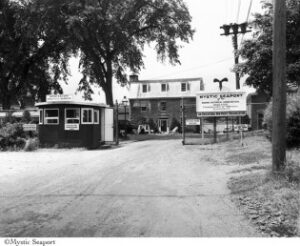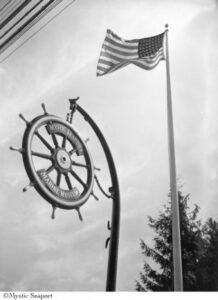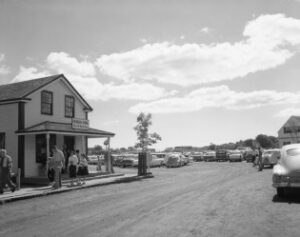Growth and enhancement of the Museum continued in the 1950s with the arrival of the coasting schooner Australia in 1951 and the schooner yacht Brilliant in 1952. The Mariner Training Program expanded, with the Brilliant taking groups of sea scouts on week-long coastal cruises. With the grounds stabilized behind stone bulkheads, attention turned to shaping the waterfront street as buildings were moved in or built. In 1955, “activists”–now called interpreters–began to work in the exhibits to explain the historical context and significance of the exhibits and artifacts. By the late 1950s the Museum had 6,000 members and was hosting a quarter-of-a-million visitors a year. More than 1,000 private boats tied up at its piers in July and August 1956. To preserve the period flavor of the site, visitor parking was moved from the present site of the Village Green to locations across the street.

1950
- Office of Volunteer Services established.
- First Dyer Dhow Derby.
1951
- Buckingham House arrives by barge from Old Saybrook, CT.
- Staff now 27 full-time, 14 part-time.
- Admission $.75 Adults, $.25 Children.
1952
- Briggs Cunningham presents schooner-yacht Brilliant.
- S.S. United States sets transatlantic speed record.
1953
- Guided tours of the Museum offered for the first time, led by college students.
- Summer — Brilliant begins weekly cruises for Mariner Training Program.

1954
- Mystic Seaport 25th anniversary celebration events held.
- Hurricanes Carol and Edna damage Museum.
- 21 January — First nuclear submarine, Nautilus, launched on the Thames River in Groton, CT, eight miles from Mystic Seaport.
1955
- First session of Munson Institute of American Maritime History summer graduate program.
- Summer — Exhibits “activated” with live attendants; beginning of live interpretation at Mystic Seaport.
1956
- First use of containerization as means of shipping goods globally.
1957
- Evidence of Charles W. Morgan stern windows, hidden since 1890s, discovered. Windows and original stern decoration replaced.
- Staff now 60 full-time.
- Admission: $1.50 Adults, $.25 children.

1958
- 3 August — Nuclear powered submarine Nautilus “achieved the impossible” by reaching the geographic north pole—90 degrees north.
- First commercial transatlantic jet flight.
1959
- Spring — South parking lot opened, replacing parking area on present Village Green. First attempt to preserve period mood by isolating Museum from auto traffic.
- International Treaty makes Antarctica a scientific preserve.


